![]()
![]()
![]()
Use LEFT and RIGHT arrow keys to navigate between flashcards;
Use UP and DOWN arrow keys to flip the card;
H to show hint;
A reads text to speech;
124 Cards in this Set
- Front
- Back
|
COLEOPTERA
CICINDELIDAE (Tiger Beetle) - Antannae- long and curves back; head wider than thorax - Active, fast-running, fast-flying - Occur in bright sunlight, open sandy areas, on sandy beaches - body shape parallel sided - may bite hard -brownish, black, or green |
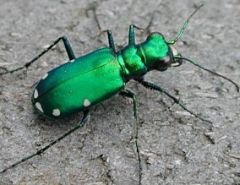
IMAGE
|
|
|
COLEOPTERA
CARABIDAE (Ground Beetle)- - head is narrower than thorax; antannae between eyes and base on mandible, ridges on back - common, found on ground, beneath obects - run rapidly, seldomly fly - predators - beneficial; gives off smell when handled - generally black and shiny (sometimes brightly colored) |
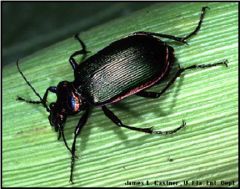
IMAGE
|
|
|
COLEOPTERA
DYTISCIDAE (Predaceous Diving Beetle) - abundant in ponds, lakes, and streams - excellent swimmers, move hind legs in unison when swimming - frequently fly to lights - adults and larvae feed on various small aquatic animals including fish - larvae is called "water tigers," sicklelike jaws - oval, flattened, and fringed with hairs - black brown or yellowish often with bright markings |
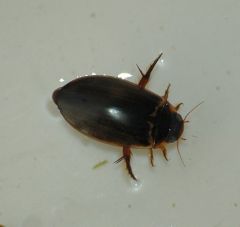
IMAGE
|
|
|
COLEOPTERA
GYRINIDAE (Whirlygig Beetle) - oval - two pairs of compound eyes, allows them to look for enemies - very short hind legs - short and stubbed antannae - usually seen swimming in groups in a gyrating fashion on the surface of ponds and streams - swim rapidly and well both above and below water - some adults when handled give off a scent like that of a pineapple - black, rarely metallic green |

IMAGE
|
|
|
COLEOPTERA
HYDROPHILIDAE (Water Scavenger Beetle) - breathe oxygen while underwater from a stored air bubble under the elytra that is periodically renewed by surfacing - short clubbed antannae - what appear to be long slender antannae are actually long elongated mouthparts (palpe) - eggs are usually laid singly on water plants or carried by mother until they hatch - some species weave a silk envelop for a packet of eggs - adults feed on rotting plant material, fungi, and dung. Some are predators. - larvae is mainly carniverous, preying on snails and other easily captured victims. Are very voracious. - black, brown, or yellow, sometimes patterned |
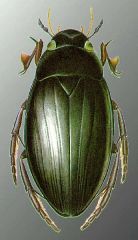
IMAGE
|
|
|
COLEOPTERA
HISTERIDAE (Hister Beetles) - antannae elbowed and clubbed - oval bodied - exposing 1 or 2 abdominal sections - like to eat dung and sap - feeds on other insects attracted to dung or sap -hard-bodied -shiny black (Some with red markings) |
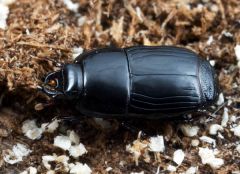
IMAGE
|
|
|
COLEOPTERA
SILPHIDAE (Carrion Beetle) - "carrion" means dead meat - front wing broadens towards tail or shows 1-3 parts - black, usually with yellow, orange, and red markings - clubbed antannae - commonly found on carrion and decay vegetation - front wings nearly cover abdomen - buries dead animals (sexton) -front wing short, exposing 1-3 abdominal segments |
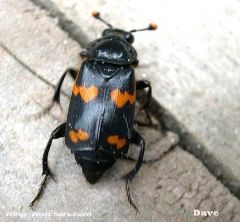
IMAGE
|
|
|
COLEOPTERA
LUCANIDAE (Stag Beetle)- - elongated-robust - madible-like jaws (males large, females small) - big - antannae elbowed, 3 or 4 segments - segments of dub being help together in a tight ball - black to reddish brown - most adults adults feed on sap flowers, larvae live in decaying legs and stumpings, apprarently feeding on the joices of rotting wood |
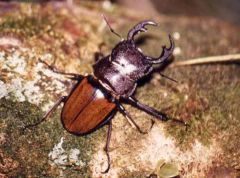
IMAGE
|
|
|
COLEOPTERA
PASSALIDAE (Bess Beetles) - horns directed forward - longitudinal lines - segments not of club not capable of being held together in a tight ball - colonies are formed in well-decayed logs or stumps -shiny black with short horn bent forward on top of the head - Only one species here in the US, rest in tropics - larvae of tropical species used as food by certain natives |
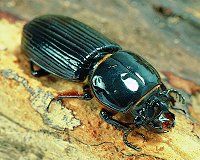
IMAGE
|
|
|
COLEOPTERA
SCARABAEIDAE (Scarab/Dung Beetle)- - includes dung beetles and june beetles - white grubs eating at lawn (feed on roots of plants) - rolls dung, area for eggs, created food for grub larvae - oval, elongate, stout, able-bodied - lamellate antannae (3 parts) |
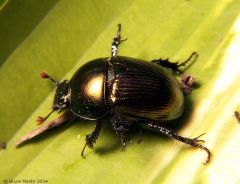
IMAGE
|
|
|
COLEOPTERA
BUPRESTIDAE (Metallic Wood-Boring Beetles)- - striking metallic colors - thick forewings are corrugated (kinky), head is deeply inserted into the first thoratic segment - many are forest dwellers, can be seen visiting flowers to feed on pollen and nectar - attacks plants, pest species -larvae bore under bark, and roots of trees. Called flat-headed borers |

IMAGE
|
|
|
COLEOPTERA
ELATERIDAE (Click Beetle)- - brown or black - named for their ability to click and jump - when put on back, it will jump into the air until it is righted - prosternum with an elongated lobe extends prosteriarly into a mesosternae depression; this feature, plus a loose articulation of the prothorax enables these beetles to "click" - adults occur on foliage and flowers, under bark or in rotting woodl many don't feed - larvae (wireworms) usually feed on roots and seeds - some are injurious to agricultural crops |
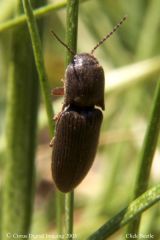
IMAGE
|
|
|
COLEOPTREA
LAMPYRIDAE (Firefly)- - head covered with a shield called a protonotum - brown or black, frequently with yellow or orange - luminous - both sexes light up - different species have different rhythms - sometimes mimicing occurs, and then eat the other species - feed on various invertebrates, including snails - larvae live on the ground, under bark, in moist swampy places |

IMAGE
|
|
|
COLEOPTERA
CANTHARIDAE (Soldier beetles)- - long and skinny - head is not covered by protonotum - soft bodied - black or brown, with yellow or orange - found on flowers or foliage - feed on pollen or nectar - similiar to lightning bugs |
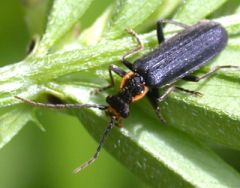
IMAGE
|
|
|
COLEOPTERA
LYCIDAE (Net-winged beetles)- - soft body - head concealed from above - usually yellow to red, with black markings - live on flowers, vegetation, foliage of trees, and shrubs - adults feed on plant juices and other insects - larvae are predacious and live under bark - flat broad flexible wings |
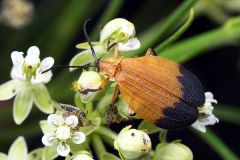
IMAGE
|
|
|
COLEOPTERA
CLERIDAE (Checkered beetle)- - elongated, almost cylindrical; covered with a dense coat of short hairs - thoracic segment is long at the front and short at rear - clublike antannae - patterns of often bright contrasting colors; forewings may be checkered - some go to flowers where sap is flowing and search for insects in the sap and soil |
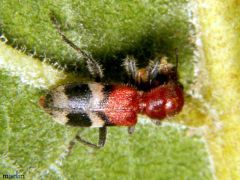
IMAGE
|
|
|
COLEOPTERA
COCCINELLIDA (Ladybugs)- - short and clubbed antannae, three to six segments - shape often distinctive - some have been used to combat scaled orchard pests -torsal claws toothed -head generally concealed by protonotum |
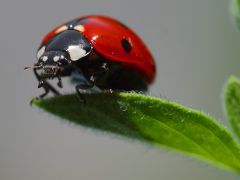
IMAGE
|
|
|
COLEOPTERA
TENEBRIONIDAE (Darkling Beetle)- - found under rocks and barks of trees - nocturnal - feed on dead plants, green plants, and fungi - gather stuff dropped by ants near ant hills - stand almost on head when alarmed - mostly unable to fly - hindwings are either poorly developed or absent - malodorous - larvae are meal worms -some "play possum" |
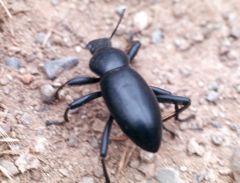
IMAGE
|
|
|
COLEOPTERA
MELOIDAE (Blister Beetle)- - head is wider than protonotum - occur in flowers and foliage - body contains cantharidin, an irritant that causes painful blistering (even after death), cantharidin can be extracted for medicinal purposes - feed on plants and can be pests - larvae are parasitic, feed on grasshopper eggs and sometimes bees - may completely defoliate a plant - pests of potatoes, tomatoes, beans, cotton and other crop plants |
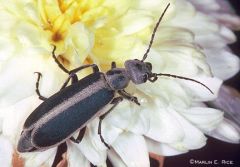
IMAGE
|
|
|
COLEOPTERA
CERAMBYCIDAE (Long-horned Beetle)- - long antannae, usually longer than body, usually rise - notched eyes - many attractive colors - larvae mostly feed on solid tissue of dead or dying plants, in trunks of fallen or cut trees - many species are very destructive to trees and cut logs - body elongate, usually cylindrical |
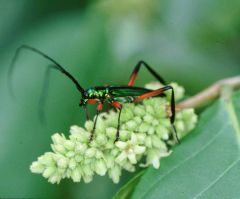
IMAGE
|
|
|
COLEOPTERA
CHRYSOMELIDAE (Leaf Beetles)- - head is small, sometimes is concealed beneath the forward projecting first thoracic segment - mouth parts are on the underside of the body - 11 segments antannae are short and thread-like, slightly broadened at the tips - legs are short, have muscles for jumping - eggs may be laid in or on in th the good, plants, or debris around them - some feed on aquatic plants - economically destructive - feed upon roots, spread fungus and disease -Best known species: Colorado Potato Beetle -generally oval |

IMAGE
|
|
|
COLEOPTERA
CURCULIONIDAE (Weevils)- - have snouts - elbowed shaped antannae, clubs at end of antannae - pests of cultivated plants, fruits, nuts, etc. - play dead when disturbed |
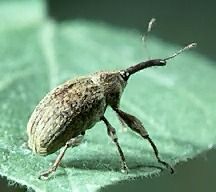
IMAGE
|
|
|
HOMOPTERA
CICADIDAE (cicadas) - Most are large, blackish - Only males produce sounds -Some live 2-5 years. -Periodical cicadas live 13-17 years - wing veins reddish -17 year cicadas are northern, often have greenish markings |

IMAGE
|
|
|
Coleoptera
Staphylinidae (Rove Beetles) - long, shiny - threadlike antennae -front wing short -found on carrion, on the ground, or under objects - some larger species bite |

IMAGE
|
|
|
Diptera
Tipulidae (crane flies) - Mosquito like - Have very long legs - Brownish or gray. -few have dark markings -they do not bite -long narrow wings |
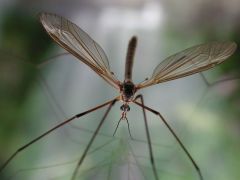
IMAGE
|
|
|
Diptera
Culicidae (mosquitoes) -vector of diseases (malaria, yellow fever) -wings long narrow with scales along veins and wing margin -Antennae in males very plumose (hairy) - Females have few short hairs - Larvae aquatic. Breathe at the surface, some have a breathing tube at the end of the body - active at night/dawn/dusk -Only the females bite |
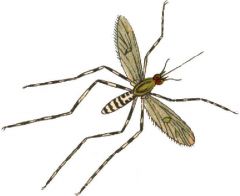
IMAGE
|
|
|
Diptera
Chironomidae (midges) - very similar to mosquitos, often mistaken for them - they do not bite - hold their wings at side when at rest - antanne in males are feathery |

IMAGE
|
|
|
Diptera
Simuliidae (black flies) - black - rather squat - large rounded wings |
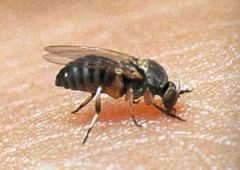
IMAGE
|
|
|
Diptera
Stratiomyidae (Soldier Flies) - third segment of antennae rounded or elongate - wasp like (Batesian Mimicry) - browinish or metallie blue-black |
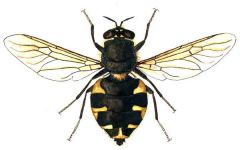
IMAGE
|
|
|
Diptera
Tabanidae (horse flies/deer flies) -Stout bodied -medium sized to large -Females bloodsucking -eyes meets dorsally in males -eyes seperate in females -Eyes are brightly colored in many species -Black or brownish |
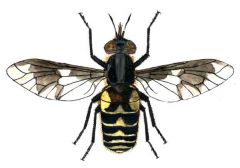
IMAGE
|
|
|
Diptera
Asilidae (robber flies) - Top of the head hollowed out between eyes -Hairy or nearly bare -face usually "bearded" - legs and thorax large - Some resembles bumblebees while some resemble damsel flies |
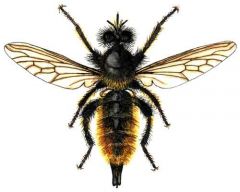
IMAGE
|
|
|
Diptera
Bombyliidae (bee flies) -stout bodied and hairy - medium to large -wings at rest are held outstretched -some have patterned wings |
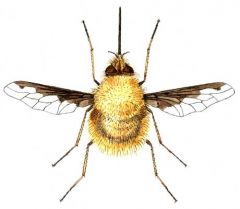
IMAGE
|
|
|
Diptera
Syrphidae (flower flies) - yellow, brown, or black - bare species strongly resemble wasps - Hairy species resembles bees - Do not bite or sting - Important pollinators |
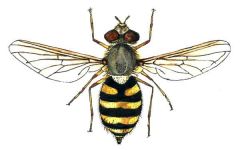
IMAGE
|
|
|
Diptera
Tephritidae (Fruit Fly) - often brightly colored - wings usually spotted or banded - larvae called maggots |
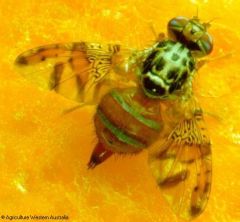
IMAGE
|
|
|
Diptera
Drosophilidae (pomace flies) - yellowish or browinish -arista plumose -found around fruit left out in the kitchen - used in genetics research |
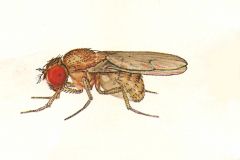
IMAGE
|
|
|
LEPIDOPTERA
SESIIDAE (Clear Winged Moths) - narrow, partly transparent wings, dark bodies banded with yellow or red, fringes of hair on the legs - antennae taper and bear tuft of bristles at the tip - mimicry of wasps - adults visit flowers; caterpillars bore into the stems, roots, and bark of treees - fomerly called the Aegeriidae family |
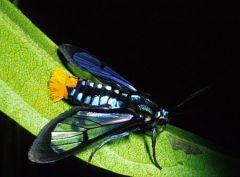
IMAGE
|
|
|
LEPIDOPTERA
TORTICIDAE (Tortricid Moths)- - small, mottled brown, tan, yellow-grey, or black and white - square tipped fore wings, shaped like a shield when folded - caterpillars live in rolled leaves held together with silk or bore into foliage - adults do not feed - called "millers" |

IMAGE
|
|
|
LEPIDOPTERA
HESPERIIDAE (Skippers)- - characteristics of both butterflies and moths - large heads, thickset bodies, short wings - antennae are set far apart and end in a small hook - hold wings at a 45 degree angle and hind wings horizontal while at rest - sip nectar or extract organic nutrients from decaying matter - |
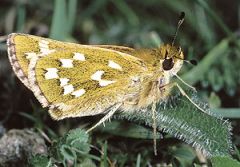
IMAGE
|
|
|
LEPIDOPTERA
PAPILIONIDAE (Swallowtails)- - adult form - long "tails" projecting from hind wings - boldly patterened in black, yellow, or white; often have spots - front legs are fully developed in both genders - "papillon" means butterfly in French - most wings of some are tailed - Give out a strong odor |
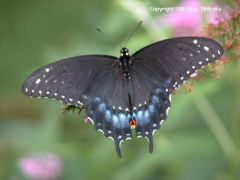
IMAGE
|
|
|
LEPIDOPTERA
PAPILIONIDAE (Swallowtails)- - larvae form - Y-shaped retractile organ called an "osmeterium" on top of the thorax, which gives off a foul-smelling odor - feed on foliage of trees |

IMAGE
|
|
|
LEPIDOPTERA
PIERIDAE (Whites/Sulfurs)- - white, yellow, or orange - rounded eings and simple wing patterns which often consist of a narrow black border - antennae end in a distinct club - full-sized fore legs used for walking - found in open, sunny places - Larvae smooth, green, slender, not very hairy |
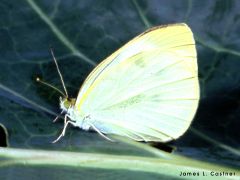
IMAGE
|
|
|
LEPIDOPTERA
LYCAENIDAE (Hairstreaks/Blues)- - brillant blue, violet, or coppery wings, sometimes with tiny tail-like projections from the margins of the hind wings - adults visit flowers - small size - females have normal forelegs, males have smaller ones which lack claws - |

IMAGE
|
|
|
LEPIDOPTERA
DANAIDAE (Milkweed Butterflies)- - usually orange or brown with black or white speckles - toxic to predators - bold patterns on both caterpillars and adults |
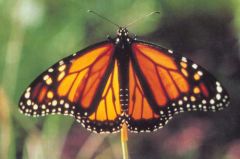
IMAGE
|
|
|
LEPIDOPTERA
NYMPHALIDAE (Brush-footed)- - large variations on size and color - covered with long, hairy scales and short forelegs - antennae are scaled, often strongly clubbed - larvae have branching spines |
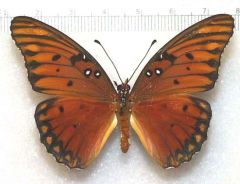
IMAGE
|
|
|
Diptera
Muscidae (House Fly) - Parallel sided or narrowed distally - Common Pests - short fleshy proboscis - larva breeds in filth - spread disease - adults feed by lapping up liquids |
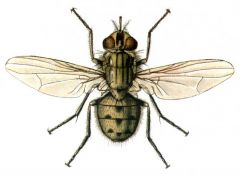
IMAGE
|
|
|
DIPTERA
HIPPOBOSCIDAE (Louse Fly)- - leathery, flattened - parasites - occur on species - wingless - suck blood |
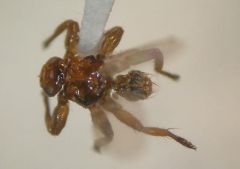
IMAGE
|
|
|
Diptera
Calliphoridae (blow fly larvae) - scavengers - lives in dung, carrion, and similar materials |
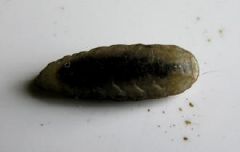
IMAGE
|
|
|
DIPTERA
CALLIPHORIDAE (Blow Fly) - often metallic - row of stout bristles on either side of the the thorax - feathery tip of antanne - metallic green or blue |
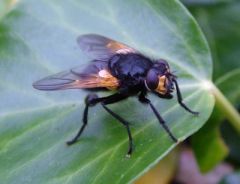
IMAGE
|
|
|
Diptera
Tachinidae (tachinid flies) - Some hairy or bee-like - Most look like house flies - larvae are parasites - bristle like tip of the antanne is bare |
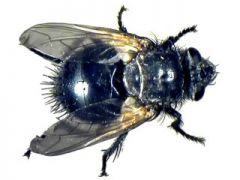
IMAGE
|
|
|
TRICHOPTERA-
- resemble moths - minute hair on wings - long and slender legs with spurs - long, multisegmented antennae - wings are held rooflike over body at rest |
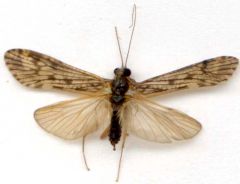
IMAGE
|
|
|
LEPIDOPTERA
SATYRIDAE (Satyrs, Nymphs, Artics)- - dull, brown, or tawny - one or more eyespot on each wing - adults seldom visit flowers |
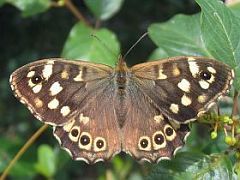
IMAGE
|
|
|
LEPIDOPTERA
PYRALIDAE (Pyralid Moths)- - small to medium sized - long palps which form a snout like projection from the head - larvae feed on foliage and plant debris - some are aquatic |
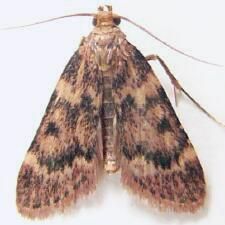
IMAGE
|
|
|
LEPIDOPTERA
SATURNIIDAE (Giant Silkworm Moth)- - largest moths - wings usually with eyespots - featherlike antennae - brightly colored |
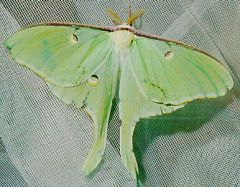
IMAGE
|
|
|
LEPIDOPTERA
SATURNIIDAE (Giant Silkworm)- - larvae form - green - large spines - fat |
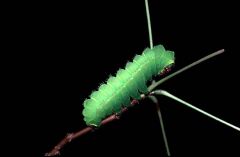
IMAGE
|
|
|
LEPIDOPTERA
SPHINGIDAE (Sphinx Moth)- - larva - fat - soft spinlike processs - "hornworm" |
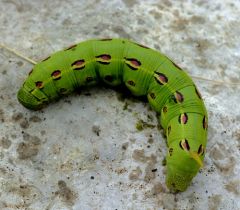
IMAGE
|
|
|
LEPIDOPTERA
SPHINGIDAE (Sphinx Moth)- - also known as a "Hawk Moth" - medium to large in size - wings are relatively small - antennae are thick and somewhat spindle shaped |
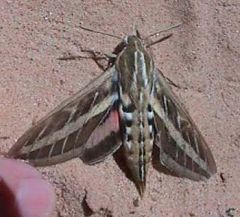
IMAGE
|
|
|
Mecoptera
Boridae (snow scorpionflies) - long antanne - fairly long slender legs - prolonged face that ends in biting jaws - wings reduced or absent |
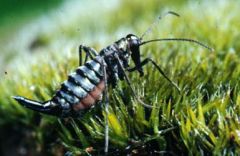
IMAGE
|
|
|
Mecoptera
Panorpidae (Common Scorpionflies) - male gentalia looks like scorpion's tail - slender bodied - brownish insects - long threadlike antanne - feeds on dead and dying insects, nectar, and rotting fruit |
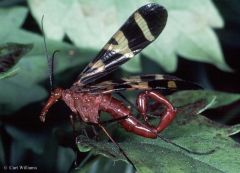
IMAGE
|
|
|
Siphonaptera (Fleas)
- brown to black - adult thin flat body -parasite - Caused Bubonic Plague - wingless -ectoparasites - usually jumping |
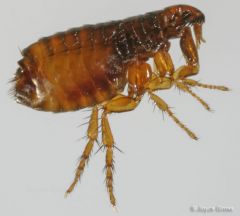
IMAGE
|
|
|
ODONATA
AESHNIDAE (Darners) - mostly large - strong flying dragonflies - patrol margins of ponds, lakes, and marshes - blue or green - compound eyes in contact on dorsal (upper) side of head |
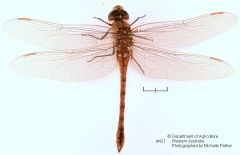
IMAGE
|
|
|
ODONATA
LIBELLUIDAE (Skimmer) - Can be seen around ponds and marshes - Many brightly colored - Dragonflies hold their wings out flat when resting - wings are wider than body is long - many have spots ot bands on wings |
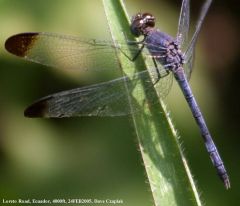
IMAGE
|
|
|
ODONATA
COENAGRIONIDAE (Narrow-Winged, Damsel Flies) - Hold their wings behind their back at rest. - Most familiar species "Bluet" - Front wing and hind wing alike in size and shape - very slender abdomen |
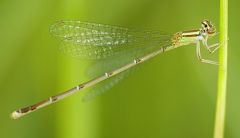
IMAGE
|
|
|
ODONATA
LESTIDAE (Spread-Winged) - slender and long - clear wings narrow at stalks at the base - named for how their wings are diverged at rest |
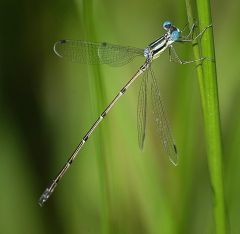
IMAGE
|
|
|
HOMOPTERA
MEMBRACIDAE (Tree hoppers) - Jumping insects - Vary in shape - some appear humpbacked while some look like thorns - Most species feed on trees and shrubs while others feeds on weeds and grasses |

IMAGE
|
|
|
HOMOPTERA
CERCOPIDAE (froghoppers/spittlebugs) - Adults called Froghoppers - Larvae called spittlebugs - small to medium sized |
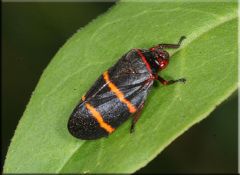
IMAGE
|
|
|
HOMOPTERA
CICADELLIDAE (Leaf Hopper) - body is usually parallel sided - sucking mouthparts - brightly colored- - thickened part of the antennae very short and ending with a bristle - two simple eyes - base of middle legs close together where they originate under the thorax - second largest family in the Hemiptera - pests of plants - discharge a clear honey-like liquid through their anus which attracts ants |
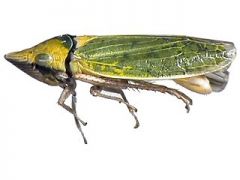
IMAGE
|
|
|
HOMOPTERA
FULGORIDAE(Fulgorid planthoppers) - wedge shaped - blunt hornlike projection on head - antanne short |

IMAGE
|
|
|
ODONATA
GOMPHIDAE (Clubtails) -Compound eyes don't meet on dorsal side of head. -Abdomen tip is clubbed shaped - Dark brown, w/ yellowish or green markings. - fly without hovering |
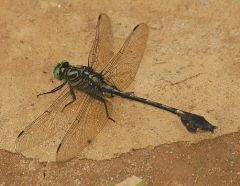
IMAGE
|
|
|
PLECOPTERA (Stoneflies)
- antanne long thread like - flattaned soft bodied - chewing mouthparts |
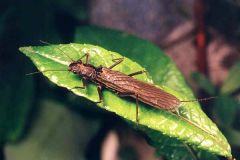
IMAGE
|
|
|
HOMOPTERA
APHIDAE (Aphids) - pear shaped. Wings at rest usually held vertical above body - some winged, some wingless - pests of plants - females give birth to babies (instead of eggs) - release honeydew from their anus - some live closly associated with ants |
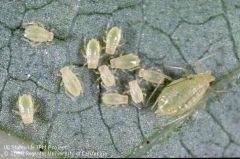
IMAGE
|
|
|
HOMOPTERA
DACTYLOPIIDAE (Scale) - females flattened and oval - body hard, smooth or covered with wax - antanne reduced or absent - legs may be present or absent |
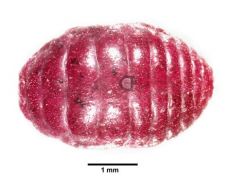
IMAGE
|
|
|
THYSANOPTERA (Thrips)
- Mouthparts rasping or sucking - Intermediate between complete and incomplete - Pale to blackish - Anteanne short - wings long and narrow - Wings frigned |
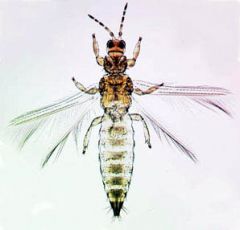
IMAGE
|
|
|
MEGALOPTERA (Dobsonflies)
- only 20 species in America - densly veined wings - lack forking veins like Neuoptera - large hing wings |
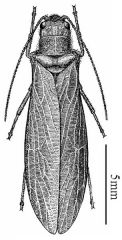
IMAGE
|
|
|
ISOPTERA (Termites)
-Small -sofe-bodied -pale colored - soldiers have huge heads - antanne short -winged or wingless |
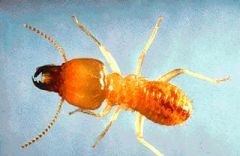
IMAGE
|
|
|
MANTODEA (mantis)
- Antanne short - Fron femora and tibiae armed with spines and fitted for catching prey - Predacious - middle and hind legs slender -prothorax lengthed |
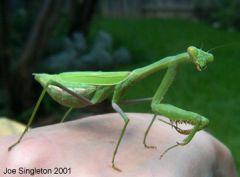
IMAGE
|
|
|
BLATTODEA (Roaches)
-Body flattened - head concealed from above by protonotum - wings usually present - antanne long and slender |
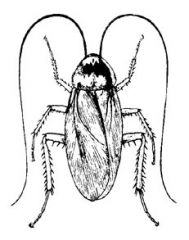
IMAGE
|
|
|
GRYLLOBLATTODEA (Ice Insects)
- slightly resembles crickets and roaches (makes the family name) - small - wingless - brown to black - primitive |
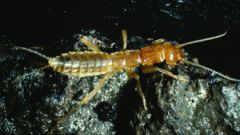
IMAGE
|
|
|
Dermaptera (earwigs)
- incomplete metamorphsis - pincer like appendages at end of abdomen - flattened bodied - antanne threadlike |
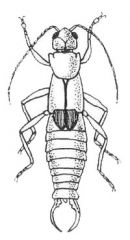
IMAGE
|
|
|
PHASMATODEA (Walking Sticks)
- body and legs very long and slender - wingless -look like twigs - antanne long and slender |
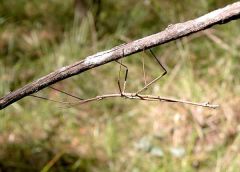
IMAGE
|
|
|
MALLOPHAGA (Chewing Lice)
- Small - wingless - flattened ectoparasites - mandible jaws - antanne short - short legs |
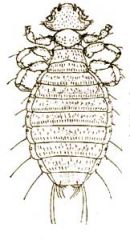
IMAGE
|
|
|
PROTURA
- sucking mouthparts - Incomplete metamorphosis - whitish - lack eyes, wings, and antanne |
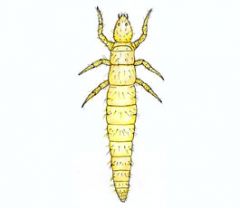
IMAGE
|
|
|
COLLEMBOLA
- springtails - no wings chewing mouthparts - minute - antanne short - furcula |
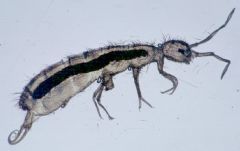
IMAGE
|
|
|
THYSANURA (silverfish)
- 2-3 tail like appendages at the end of abdomen - Long antanne - elongate body - chewing mouthparts |
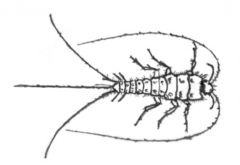
IMAGE
|
|
|
EPHEMEROPTERA (Mayflies)
- live only for a day - dies after mating - forwings triangular - 2-3 hairlike tails |
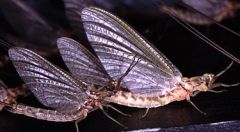
IMAGE
|
|
|
ANOPLURA (Sucking Lice)
- small -flattened - wingless - ecto parasites |
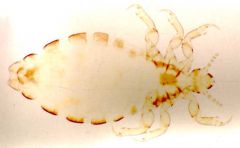
IMAGE
|
|
|
ORTHOPTERA
ACRIDIDAE (short horned grasshoppers) - antanne short - face vertical - large hind legs |
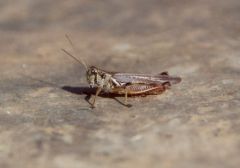
IMAGE
|
|
|
ORTHOPTERA
TETTIGONIDAE (short horned grasshoppers/katydids) - large hind legs - greenish or brownish - long antanne |
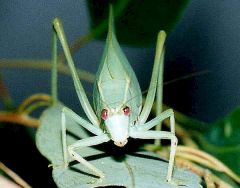
IMAGE
|
|
|
ORTHOPTERA
GRYLLIDAE (Tree Cricket) - flattened - wings of females thickened and feathery - males produce sounds - long hind legs |
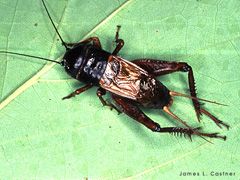
IMAGE
|
|
|
ORTHOPTERA
GRYLLOTALPIDAE (Mole Cricket) - brownish - body elongate - spadelike front legs |
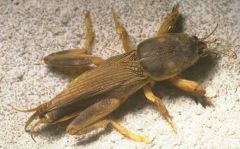
IMAGE
|
|
|
ORTHOPTERA
TETRIGIDAE (Pygmy Grasshoppers) - protonotum extends far back over the abdomen and tapers to a point - females larger and heavier than males - feed on algae |
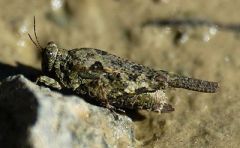
IMAGE
|
|
|
ORTHOPTERA
Gryllacrididae (camel crickets) - brownish - humped - long antanne - most males do not produce sounds |
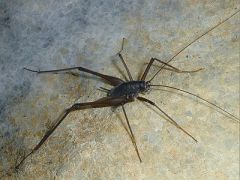
IMAGE
|
|
|
STREPSIPTERA
(Twisted-Winged Parasite) - minute - seldom more than 1/8" long - parasites with wings - males look like flies, but have no useful mouthparts - attacks other insects - forked or comblike antanne |
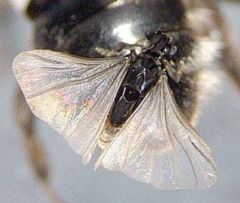
IMAGE
|
|
|
NEUROPTERA
CHRYSOPIDAE (Green Lacewings) - wings greenish - eyes golden or coppercolored - adults and larvae feed on aphids - gives off umpleasent odor when handled |

IMAGE
|
|
|
NEUOPTERA
MYRMELEONTIDAE (antlion: larvae) - knobbed antanne - eat ants and other insects - live at the bottom of a conical pit in dry sandy or dusty areas - sickle like jaws |
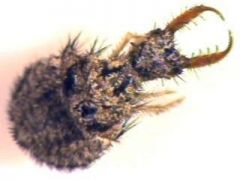
IMAGE
|
|
|
NEUROPTERA
MYRMELEONTIDAE (Antlions: adult) - Feed on nectar - resembles damselfies - poor fliers - longer clubbed antanne - soft elongate bodies |
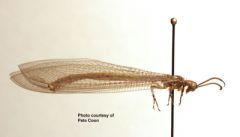
IMAGE
|
|
|
HEMIPTERA
CORIXIDAE (Water boatman) - dorsal surface of body flattened - narrow dark crosslines - front legs short - hind legs elongate - swim rightside up - do not bite - seen swimming in shallow ponds |
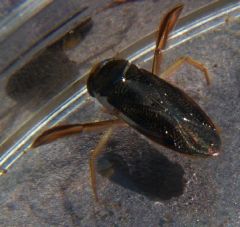
IMAGE
|
|
|
HEMIPTERA
NOTONECTIDAE (Back Swimmers) - dorsal surface of body convex - back legs long - swim on their backs (hence the name) - rest at surface with head hanging down into water - painful bite - ponds and lakes |
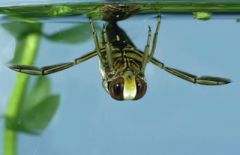
IMAGE
|
|
|
HEMIPTERA
BELOSTOMATIDAE (Giant Water bugs) - front legs used for catching prey - hind legs somewhat flattened - ponds lakes - can inflict a painful bite - "toe biters" |
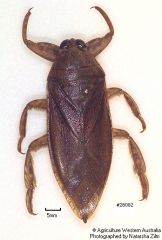
IMAGE
|
|
|
HEMIPTERA
NEPIDAE (water scorpions) - slender and elongate - some species resembles walking sticks - some species are elongate oval - front legs raptorial - brownish |
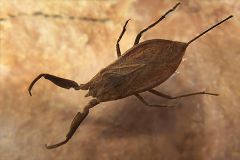
IMAGE
|
|
|
HEMPITERA
GELASTOCORIDAE (toad bugs) - small -heavy-bodied - toad-like - jumping insects - front legs short - live along ponds and streams |
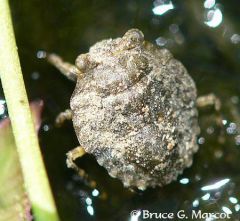
IMAGE
|
|
|
HEMIPTERA
GERRIDAE (Water striders) - middle and hind legs long - front legs short - some are winged, some wingless - Dart about on the surface film of fresh and salt water |
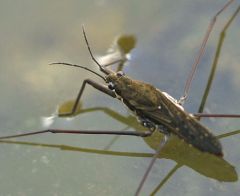
IMAGE
|
|
|
HEMIPTERA
CIMICIDAE (bed bugs) -flat -oval - brownish - live in creases in matresses - suck blood |
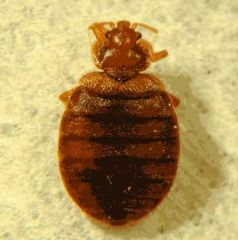
IMAGE
|
|
|
HEMIPTERA
MIRIDAE (leaf bugs) - small - oval or elongate - live on plants -brightly colored |

IMAGE
|
|
|
HEMIPTERA
REDUVIIDAE (Assassin Bugs) - oval - generally elongated bodies - end of abdomen extends beyond wings - live in meadows |
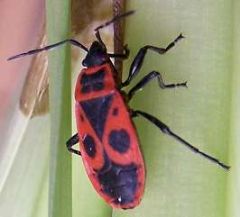
IMAGE
|
|
|
HEMIPTERA
PHYMATIDAE (ambush bugs) - small - greenish brownish - femora muscled for catching prey - usually seen on flowers - eats wasp, bees, and ants |
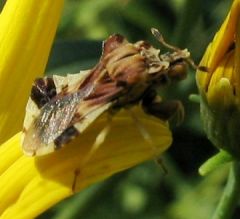
IMAGE
|
|
|
HEMPITERA
TINGIDAE (lace bugs) - antanne and beak 4 segmented - greyish - somewhat rectangluar - seen eating foliage of trees and shrubs |
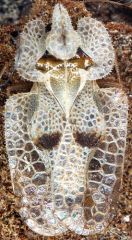
IMAGE
|
|
|
HEMIPTERA
LYGAEIDAE (Seed Bug) - small to medium sized - elongate oval - most brownish, some brightly patterned - live in meadows - some feed on sap, some predacious |
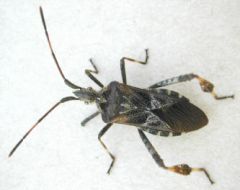
IMAGE
|
|
|
HEMPITERA
COREIDAE (Leaf Footed Bugs) - dark colored - head narrow - hind wing leaf like - some plant feeders some predacious |
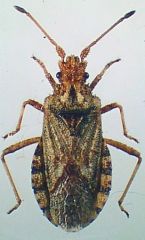
IMAGE
|
|
|
HEMIPTERA
PENTATOMIDAE (stink bugs) - broadly oval - somewhat shield shaped - produce disagreeable odor - 5 segmented antanne |
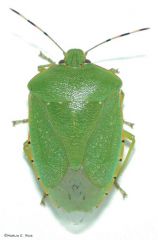
IMAGE
|
|
|
HYMENOPTERA
ICHNEUMONIDAE (Ichneumons) - Wasp like - vary in size and color, most have long ovipositer - antanne 1/2 as long as body |
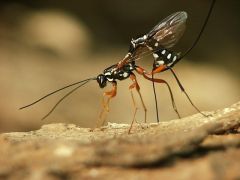
IMAGE
|
|
|
HYMENOPTERA
MUTILLIDAE (Velvet Ants/Cow Killer) - they are wasps that resemble ants but are hairy - females inflict a very painful sting - ave a structure called a stridulitrum on the metasoma which they use to produce a squeaking, chirping sound (more like a high pitched hum) to warn would-be predators - females lack wings - |
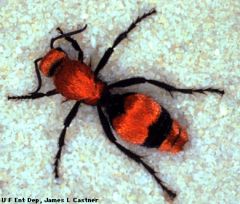
IMAGE
|
|
|
HYMENOPTERA
FORMICIDAE (Ants) - dorsal hump - queens ans males usually have wings - workers wingless - live in ant colonies - antanne strongly elbowed |
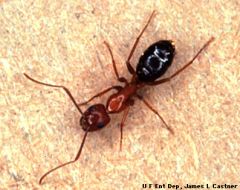
IMAGE
|
|
|
HYMENOPTERA
Vespidae (Paper Wasps) - make nests with papery material - threadlike antanne - triangular pronotum - fold their wings lenthwise over body at rest - notched eyes |
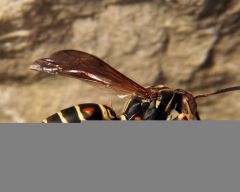
IMAGE
|
|
|
HYMENOPTERA
APIDAE (bees) - solitary or social - some hairy - yellow and black markings - Bumblebees live mostly on the ground, usually in a deserted mouse hole - Honeybees nest in hives |
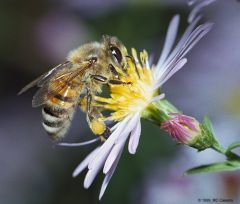
IMAGE
|
|
|
HYMENOPTERA
TENTHREDINIDAE (Sawflies) - black or brown - family common sawflies - long thread-like antanne |
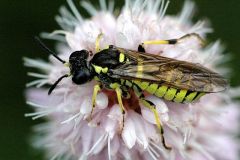
IMAGE
|
|
|
HYMENOPTERA
SIRICIDAE (Horntails) - wasplike - brownish or black - triangular plate at end of abdomen - larvae tunnel in wood |
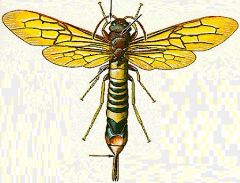
IMAGE
|
|
|
HYMENOPTERA
CYNIPIDAE (gall wasps) - humpbacked - abdomen short and flattened on sides - females lay eggs in flowers - antanne long, not elbowed |
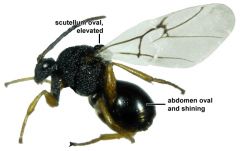
IMAGE
|
|
|
HYMENOPTERA
COLLETIDAE (Plaster bees) - black - wings clear - meadows garden lawns |
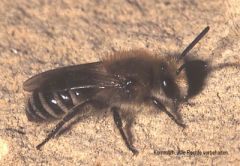
IMAGE
|
|
|
HYMENOPTERA
HALICIDAE (alkali bees) -most metallic green, some black - live in meadows - named cause may be seen nesting in alkaline clay |
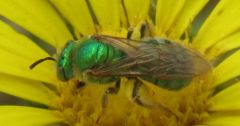
IMAGE
|
|
|
HYMENOPTERA
MEGACHILIDAE (Leaf cutter bees) - black - wings clear to brownish - among the world's most efficient pollinators because of their energetic swimming-like motion in the reproductive structures of flowers, which moves pollen, as needed for pollination - solitary bees whose pollen-carrying structure (called scopa) is restricted to the ventral surface of the abdomen (rather than on the hind legs like in all other bee families) - meadows and forest edges |
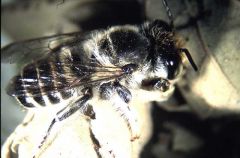
IMAGE
|
|
|
LEPIDOPTERA
ARCTIIDAE (Tiger Moths)- - often brightly spotted or banded - light colored - feed on grasses, few feed on grass and shrubs - adults are heavy bodied - wings are held roof-like over body while at rest |

IMAGE
|
|
|
LEPIDOPTERA
LYMANTRIIDAE (Tussock Moths)- - stout, hairy, brownish or whiteish - lack simple eyes (compound eyes) - males have prominent feathery antennae - adults are short-lived, do not feed - females are poor fliers (some are wingless) - reduced probocus - live in deciduous forests |

IMAGE
|
|
|
LEPIDOPTERA
LYMANTRIIDAE (Tussock Moths)- - stout, hairy, brownish or whiteish - lack simple eyes (compound eyes) - males have prominent feathery antennae - adults are short-lived, do not feed - females are poor fliers (some are wingless) - reduced probocus - live in deciduous forests |
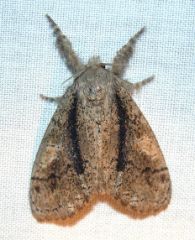
IMAGE
|
|
|
LEPIDOPTERA
NOCUIDAE (Noctuid Moths)- - slender and thread-like antennae - largest family in the Lepidoptera order - most are nocturnal - wings at rest are held flat or rooflike over the body - woodlands |
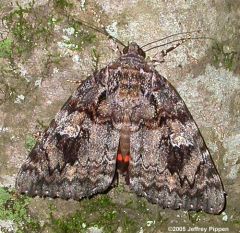
IMAGE
|

